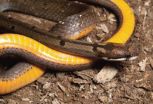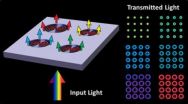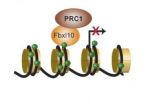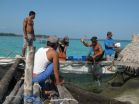(Press-News.org) A recent study of the amphibians and reptiles of Sierra Madre Mountain Range, northeastern Luzon, reveals a preliminary enumeration of more than 100 species that contribute to the unique biodiversity of the region. At present, the Luzon region's herpetological range stands at more than 150 species. Out of these, a total of 49 amphibian species have been documented, 44 of which are native and a remarkable 32 endemic. In the world of reptiles, Luzon can boast with 106 native species, 76 of which are unique to this region.
The catalogue published in the open access journal Zookeys features a fascinating range of reptiles and amphibians, such as the beautifully coloured colubrid snake Hologerrhum philippinum, which is one of the four endemic snake genera from the region and can be recognized by the vibrant-yellow skin decoration. Another species that provokes amazement is the bizarre soft-shell turtle Pelochelys cantorii. The variety described in this study includes fascinating frogs, crocodiles, snakes, lizards and many more, offering a menagerie of shapes and colours all documented in stunning photography.
With such a great array of biodiversity, the northern Philippines has been the focus of of large numbers of new species discoveries and re-discoveries of new species in recent decades, establishing it as a major regional biodiversity hotspot. The herpetological diversity of the island may grow to as many as 90-100 (70-80% endemic) amphibian species and as many as 150-160 reptiles with the contributions of ongoing biodiversity studies in the near future. It will be a major challenge to monitor these communities through time in order to assess their responses to land use changes, climate change, resource extraction, introduced species, emerging infectious disease, and habitat degradation.
With the initial baseline information provided in the survey, tremendous opportunities exist for future studies in taxonomy, biogeography, ecology and conservation of northern Luzon's amphibians and reptiles. Conservation of Luzon's vertebrate biodiversity remains an on-going effort, challenged by rapid development,logging, mining and conversion of natural habitats into agricultural lands to provide food for a burgeoning human population.
INFORMATION:
Original Source
Brown RM, Siler CD, Oliveros CH, Welton LJ, Rock A, Swab J, Van Weerd M, van Beijnen J, Jose E,
Rodriguez D, Jose E, Diesmos AC (2013) The amphibians and reptiles of Luzon Island, Philippines, VIII: the
herpetofauna of Cagayan and Isabela Provinces, northern Sierra Madre Mountain Range. ZooKeys 266: 1-120. doi:
10.3897/zookeys.266.3982
The amazing amphibians and reptiles of the Philippine island Luzon
2013-02-08
ELSE PRESS RELEASES FROM THIS DATE:
Colon cancer exhibits a corresponding epigenetic pattern in mice and humans
2013-02-08
Tumourigenesis is driven by genetic alterations and by changes in the epigenome, for instance by the addition of methyl groups to cytosine bases in the DNA. A deeper understanding of the interaction between the genetic and epigenetic mechanisms is critical for the selection of tumour biomarkers and for the future development of therapies. Human tumour specimens and cell lines however contain a plethora of genetic and epigenetic changes, which complicate data analysis. In contrast, certain mouse tumour models contain only a single genetic mutation and allow the analysis ...
Study identifies liver gene that regulates cholesterol and fat blood levels
2013-02-08
Researchers have identified a microRNA liver gene, miR-27b, which regulates lipid (cholesterol or fat) levels in the blood. This regulator gene controls multiple genes involved in dyslipidemia—abnormal blood cholesterol levels that can contribute to heart disease. Study details published in the February issue of Hepatology, a journal of the American Association for the Study of Liver Diseases (AASLD), describe a new in silico approach to identify the significance of microRNAs in regulating disease-related gene pathways.
The Human Genome Project (HGP) was completed in ...
Boston College researchers' unique nanostructure produces novel 'plasmonic halos'
2013-02-08
CHESTNUT HILL, MA (February 7, 2013) – Using the geometric and material properties of a unique nanostructure, Boston College researchers have uncovered a novel photonic effect where surface plasmons interact with light to form "plasmonic halos" of selectable output color. The findings appear in the journal Nano Letters.
The novel nanostructure proved capable of manipulating electron waves known as surface plasmon polaritons, or SPPs, which were discovered in the 1950s but of late have garnered the attention of scientists for their potential applications in fields that ...
Specific warning signs of complications in colorectal surgical patients released
2013-02-08
Chicago (February 7, 2013): Colorectal surgical patients are often discharged from the hospital with vague guidance on how to recognize complications, but researchers at the Michael DeBakey Veterans Administration (VA) Medical Center and Baylor College of Medicine, Houston, aim to change that scenario. A health services research team convened a panel of surgical experts to develop a list of postoperative complication signs that should prompt colorectal surgical patients to call their surgeons or go to an emergency room. The study on the development of this early patient-centered ...
Dickkopf makes fountain of youth in the brain run dry
2013-02-08
The hippocampus – a structure of the brain whose shape resembles that of a seahorse – is also called the "gateway" to memory. This is where information is stored and retrieved. Its performance relies on new neurons being continually formed in the hippocampus over the entire lifetime. "However, in old age, production of new neurons dramatically decreases. This is considered to be among the causes of declining memory and learning ability", Prof. Dr. Ana Martin-Villalba, a neuroscientist, explains.
Martin-Villalba, who heads a research department at the German Cancer Research ...
Scientists find key to growth of 'bad' bacteria in inflammatory bowel disease
2013-02-08
(SACRAMENTO, Calif.) — Scientists have long puzzled over why "bad" bacteria such as E. coli can thrive in the guts of those with inflammatory bowel disease (IBD), causing serious diarrhea. Now UC Davis researchers have discovered the answer—one that may be the first step toward finding new and better treatments for IBD.
The researchers discovered a biological mechanism by which harmful bacteria grow, edge out beneficial bacteria and damage the gut in IBD. This new understanding, published in the Feb. 8 issue of Science, may help researchers develop new treatments for ...
Experimental gene therapy treatment for Duchenne muscular dystrophy offers hope for youngster
2013-02-08
Jacob Rutt is a bright 11-year-old who likes to draw detailed maps in his spare time. But the budding geographer has a hard time with physical skills most children take for granted -- running and climbing trees are beyond him, and even walking can be difficult. He was diagnosed with a form of muscular dystrophy known as Duchenne when he was two years old.
The disease affects about 1 in 3,500 newborns -- mostly boys -- worldwide. It usually becomes apparent in early childhood, as weakened skeletal muscles cause delays in milestones such as sitting and walking. Children ...
Protein paves the way for correct stem cell differentiation
2013-02-08
A single embryonic stem cell can develop into more than 200 specialized cell types that make up our body. This maturation process is called differentiation and is tightly regulated. If the regulation is lost, specialized cells cannot develop correctly during development. In adulthood, the specialized cells may forget their identity and develop into cancer cells. Research from BRIC, University of Copenhagen, has identified a crucial role of the molecule Fbxl10 in differentiation of embryonic stem cells and suggests the molecule as a new potential target for cancer therapy.
"Our ...
USC research finds certain contraceptive may pose risk of Type 2 diabetes for obese women
2013-02-08
Highlights of this news release:
Six-month study finds that progestin-releasing contraceptives show a slight negative impact on metabolic markers, raising the risk for type 2 diabetes.
Contraceptive implants under the skin increase the risk more than uterine implants.
Longer and larger studies are needed to see if metabolic changes are temporary or long-term.
LOS ANGELES – A first-of-its-kind study by researchers at the Keck School of Medicine of the University of Southern California (USC) indicates that healthy, obese, reproductive-age women who use long-acting ...
Indonesian fishing communities find balance between biodiversity and development
2013-02-08
Fishing communities living on the islands of Indonesia's Karimunjawa National Park have found an important balance, improving their social well-being while reducing their reliance on marine biodiversity, according to the Wildlife Conservation Society and the University of Western Australia.
Over the past 5 years, the Government of Indonesia has turned Karimunjawa National Park—a marine paradise of turquoise seas and mangrove-ringed islands in the Java Sea just south of Borneo—into a model of co-management for the country, largely by increasing community participation ...




